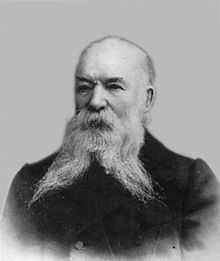Genrikh Struve

Genrikh Vasilievich Struve (also Heinrich Struve; Russian: Генрих Васильевич Струве, 10 July 1822 – 28 March 1908) was a Russian chemist from the Struve family and a member of the Russian Academy of Sciences.[1]
Genrikh Struve was born in 1822 in Dorpat (Tartu), then Russian Empire. In 1845, he graduated from the University of Tartu and continued working there in the field of chemistry till 1849. In 1846, via arrangement by his father Friedrich Georg Wilhelm von Struve, Genrikh spent a month visiting Jöns Jacob Berzelius who was impressed with both the father and his son.[2] In 1849, Struve moved to the Mineralogy Department in Saint Petersburg and worked there till 1867. In 1867, he became a criminal medicine expert in Tiflis.[2][3][4] There, he used not only chemical, but also early photographical (1885) methods for criminal analysis.[5] He had also participated in the chemical analysis o mineral springs of the area, in particular of the Matsesta spring in Sochi in 1886.[6]
Struve married Pauline Fuss, a great-granddaughter of Leonhard Euler.[7][8]
Scientific work of Struve was mostly related to inorganic and analytical chemistry. In 1853, he published first in Russia tables for evaluating chemical analyses. The same year, he suggested use of ammonium molybdate for detection of arsenic in criminal medicine and in mineral analysis, such as indicating traces of arsenic in antimony. He also synthesized a range of double salts of potassium, sodium, chromium, iron, aluminium, molybdenum and tungsten. In 1876, Struve became a member of the Russian Academy of Sciences.[2][3]
References
- ↑ List of RAN members, official site of Russian Academy of Sciences
- ↑ 2.0 2.1 2.2 Alan Henry Batten (1988). Resolute and undertaking characters: the lives of Wilhelm and Otto Struve. Springer. p. 98. ISBN 90-277-2652-3.
- ↑ 3.0 3.1 Струве in Большая Энциклопедия (Great encyclopedia), Soyuzkniga
- ↑ V. K. Abalkin et al. Struve dynasty (in Russian), St. Petersburg University
- ↑ Из истории использования исследовательской фотографии в криминалистических целях (in Russian)
- ↑ History of Matsesta Spring (in Russian)
- ↑ Генрих Оттен. Лавина жизни, Argumenty i Fakty (in Russian)
- ↑ Pauline Fuss was the daughter of Nicolas Fuss (1755-1826) and his wife Albertine Benedikte Philippine Luise Euler (1766-1822). Albertine Euler was the daughter of Leonhard Euler's eldest son Johann Albrecht Euler (1734-1800) and his wife Anna Sophie Charlotte Hagemeister.
| Jacob (1755–1841) Mathematician | Anton Sebastian President of the Imperial Diet | ||||||||||||||||||||||||||||||||||||||||||||
| Carl (1785–1838) Philologist | Ernst (1786–1822) | Gustav (1788–1829) | Friedrich Georg Wilhelm (1793–1864) Astronomer | Ludwig (1795–1828) Anatomist | Johann Christoph Gustav (1763–1828) Diplomat | ||||||||||||||||||||||||||||||||||||||||
| Otto Wilhelm (1819–1905) Astronomer | Genrikh (1822–1908) Chemist | Berngard (1827–1889) Russian governor | Karl (1835–1907) Politician | Johann Ludwig (1812–1898) | Gustav (1805–1870) Politician | ||||||||||||||||||||||||||||||||||||||||
| Karl Hermann (1854–1920) Astronomer | Gustav Ludwig (1858–1920) Astronomer | Vasily Berngardovich (1854–1912) Mathematician | Peter Berngardovich (1870–1944) Revolutionary | Alexander Berngardovich | |||||||||||||||||||||||||||||||||||||||||
| Georg Hermann (1886–1933) Astronomer | Otto (1897–1963) Astronomer | Vasily Vasilevich (1889–1965) Historian | Gleb (1898–1985) Poet | ||||||||||||||||||||||||||||||||||||||||||
| Wilfried (1914–1992) Astronomer | |||||||||||||||||||||||||||||||||||||||||||||
|